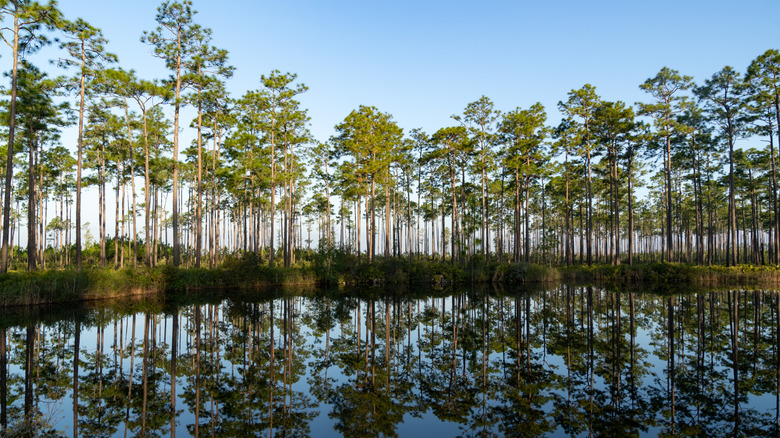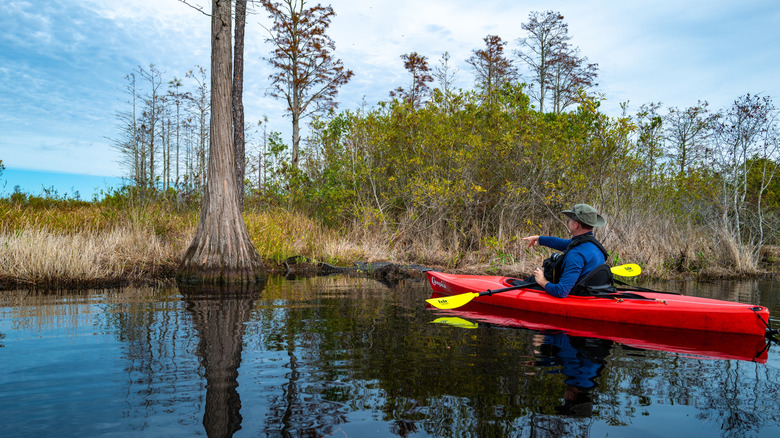One Of Georgia's Seven Natural Wonders Is The Largest Blackwater Swamp In North America
Georgia is home to the vibrant city of Atlanta, historic Savannah, and the artsy and beautiful Athens. The state's urban centers are fantastic destinations for a vacation; however, there is an outdoor wonderland that shouldn't be missed during your visit. Right along the border with Florida, near the small and infinitely charming city of Folkston, is the 700-square-mile Okefenokee Swamp. This rich environmental area is protected by the Okefenokee National Wildlife Refuge and Wilderness, the south's largest wilderness area, and it's one of Georgia's Seven Natural Wonders. Additionally, it's the largest blackwater swamp in North America. Okefenokee Swamp, along the Suwannee and St. Mary's rivers, is home to American alligators, deer, storks, herons, carnivorous plants, and even endangered species like the indigo snake. There are floating islands to explore, trails to hike, water trails for canoes and kayaks, camping, and more.
Visiting Okefenokee Swamp will require a car, as the closest major airport is Jacksonville International Airport in neighboring Florida, which is around 50 miles away. If you're just visiting for the day, or if it's really hot and humid, you can drive the 7-mile Swamp Island Drive loop to take in the scenery from the comfort of your car. It's a good idea to get a map from the visitor center first for this scenic drive. The entry fee for the park is $5 per vehicle for the week, or $15 for an annual pass. There are also a number of fee-free days, which you can see here.
Hiking and paddling at Okefenokee Swamp
If you want to be comfortable visiting the Okefenokee Swamp, the spring and fall are the best times to go, as the summer can be humid and hot. Average highs range from 74 degrees Fahrenheit in March to 80 in April, with lows in the 40s and 50s. September sees temperatures closer to 90 degrees, with October hovering in the 80s and November highs dipping into the 70s.
There are some great and relatively easy hikes in the swamp, so even if you go when it's hot, it's worth your time. You can take the Chesser Island Boardwalk Trail, which is 1.3 miles out and back with no elevation gain. It's a great, quiet spot for birding, and it's right by the Chesser Island Homestead off Swamp Island Drive, which is a preserved home of a family who worked and farmed here from the 1850s through 1971. Another hike right off the Homestead is the Edge Trail and Ridley's Island Boardwalk, a 1-mile, out-and-back route that is largely flat, with some great animal-spotting opportunities. You can also take the short, 0.5-mile Cane Pole Trail along the Suwannee Canal, where you can stop and do some fishing from the platforms and benches. This one is accessible, with asphalt and a wooden boardwalk with railings.
Consider doing a guided boat tour with one of the companies in the area, like Okefenokee Swamp Park & Adventures, but be sure to book in advance. You can also bring your own kayak or canoe, or rent one from the Stephen C. Foster State Park inside the swamp. Paddle along the Okefenokee Wilderness Canoe Trails, which are excellent for alligator-spotting.
Wildlife and camping options
Seeing the wildlife is a big draw in the Okefenokee Swamp, especially the American alligator, as there are around 15,000 in the area. You may also catch a glimpse of deer and black bears, or spy snapping turtles, frogs, and toads. Birders will have a field day spotting great blue herons, red-shouldered hawks, belted kingfishers, and even bald eagles. If you're hiking or camping, keep your eyes out for the area's fascinating carnivorous plants like pitcher plants and sundews.
If you want to camp in the swamp, there are eight overnight platforms and two islands where you can park your tent. You can also bring along canoes and kayaks for the water trails, but no motor boats are permitted. However there are some limits to how long you can stay. In the high season, which is March and April, you can stay for two nights, and from May through February, you can stay between one and four nights. Make sure to keep an eye on the weather, and bring fresh water, as the swamp water isn't recommended for consumption, even when filtered. If you're staying in the park overnight, remember that it's a swampy area, so bring some high-tech mosquito traps to make it a bit more comfortable.
While you're hiking or boating, keep an eye out for alligators, and allow them time to move on before you approach any place you see them. Stay at least 30 feet away, and do not feed them under any circumstances. Mating season is from April through June, so practice extra caution during this time. Avoid nests, stay in your boat, and keep all your limbs inside. Remember that swimming is not allowed here, and for good reason.


